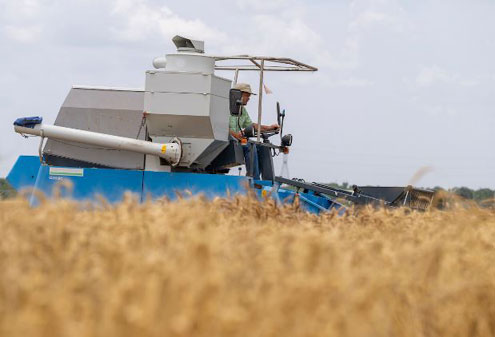Across Texas, wheat harvest results depended very much on the weather. Drought led to early termination of dryland fields, and muddy conditions are delaying ongoing harvests to the detriment of grain quality. However, across the state, it was an average year for Texas wheat.
Texas A&M AgriLife Extension Service agronomists initially predicted a good wheat season based on a good start. But conditions deteriorated in some areas, resulting in lower yields than expected, while other areas experienced better yields than in 2024.
According to the U.S. Department of Agriculture National Agricultural Statistics Service, the Texas wheat harvest was estimated to be 70% complete on June 22, with about 73% of the crop reported in fair or better condition. A total of 2.3 million acres is expected to be harvested for grain. The June crop production report forecast Texas wheat production at 69 million bushels, with an average yield of 30 bushels per acre.

South Texas region winds up early
Brandon Gerrish, Ph.D., AgriLife Extension statewide small grains specialist and assistant professor in the Texas A&M Department of Soil and Crop Sciences, Bryan-College Station, said harvest in South Texas finished quickly due to warm winter weather and hot temperatures during mid-May.
Yields for irrigated winter and spring wheat at the AgriLife Extension variety trial site near Castroville were higher than in the 2024 season.
We know most of the Winter Garden area southwest of San Antonio has been in drought for over a year now, so it is likely that irrigated wheat may have done alright, but dryland fields struggled, Gerrish said.
Rains, or lack thereof, impact Blacklands/Central Texas harvest
Gerrish said test weights are up in the southern Blacklands compared to last year due to less rain after maturity. However, producers in the northern Blacklands are not as lucky as continued rains resulted in some preharvest sprouting. Harvest is still underway for some northeast Texas producers, who are struggling with muddy fields.
Overall, yields across the Blacklands region were lower this year due to the dry conditions that persisted through winter and early spring, he said. Damage from spring Hessian fly infestations also lowered test weights in that area.
He said soft red winter wheat varieties seemed to perform better than hard red winter wheat varieties in the Hill County and north.
Dry conditions affect yields in Rolling Plains
Gerrish said while the dryland wheat south of Abilene through Central Texas failed or had very low yields, in the Rolling Plains, the yields and test weights at the AgriLife Extension yield trial in Chillicothe were better than those in 2024.
Reagan Noland, Ph.D., AgriLife Extension agronomist and assistant professor in the Department of Soil and Crop Sciences, San Angelo, said dryland yields were lowest in the southern and southeastern parts of the region that never received sufficient rainfall. Acreage in McCulloch County and surrounding counties failed or produced extremely low yields below 5-10 bushels per acre due to drought.
The yields increased, moving north through Runnels County and into the Central Texas counties surrounding Abilene, Noland said.
Emi Kimura, Ph.D., AgriLife Extension agronomist and associate professor in the Department of Soil and Crop Sciences at Vernon, said prolonged wet field conditions in May and June delayed harvest in the Rolling Plains, but it is now complete. Yields varied widely depending on the planting time. Wheat planted in October performed better than fields planted after good rains in November that were followed by dry conditions.
High Plains region experiences good yields
In the High Plains, most dryland acres are cut. Some irrigated acres are delayed due to continued rains, which is unusual for the area, Gerrish said. Areas north of the Canadian River missed many of the rains, resulting in much shorter and lower-yielding wheat.
Calvin Trostle, Ph.D., AgriLife Extension agronomist and professor in the Department of Soil and Crop Sciences, Lubbock, said spring rains in the South Plains produced better-irrigated wheat yields. The dryland wheat was a mixed bag, ranging from 30 bushels per acre yields to no harvest. He also noted the lowest level of disease incidence wheat streak mosaic and rusts or insect issues in recent memory.
Jourdan Bell, Ph.D., AgriLife Extension agronomist and associate professor in the Department of Soil and Crop Sciences, Amarillo, said the wheat harvest is still underway for the Panhandle. Yields were significantly boosted by the May rain, which produced late tillers and added grain yield.
Our dryland wheat is above average, with some farmers reporting yields of 60 or more bushels per acre, Bell said. Our irrigated wheat is also very strong, with yields greater than 100 bushels per acre.
Gerrish said the AgriLife Extension dryland test site at Bushland averaged 72-bushel yields, the highest since 2005.
While the rainfall benefited many producers, Bell and Trostle said there were still many areas impacted by hail. Gerrish said AgriLife Extension lost two test sites to hail.

